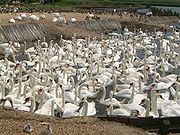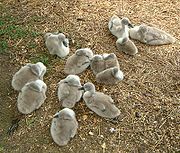
Abbotsbury Swannery
Encyclopedia


Swan
Swans, genus Cygnus, are birds of the family Anatidae, which also includes geese and ducks. Swans are grouped with the closely related geese in the subfamily Anserinae where they form the tribe Cygnini. Sometimes, they are considered a distinct subfamily, Cygninae...
s in the world. It is situated near the village of Abbotsbury
Abbotsbury
Abbotsbury is a large village and civil parish in the West Dorset district of Dorset, England; situated north-west of Weymouth. It is located from Upwey railway station and from Bournemouth International Airport. The main road running through the village is the B3157, connecting Abbotsbury to...
in Dorset
Dorset
Dorset , is a county in South West England on the English Channel coast. The county town is Dorchester which is situated in the south. The Hampshire towns of Bournemouth and Christchurch joined the county with the reorganisation of local government in 1974...
, England, 14 kilometres (9 mi) west of Weymouth on a 1 hectares (2 acre) site around the Fleet lagoon protected from the weather of Lyme Bay
Lyme Bay
Lyme Bay is an area of the English Channel situated in the southwest of England between Torbay in the west and Portland in the east. The counties of Devon and Dorset front onto the bay,-Geology:...
by Chesil Beach
Chesil Beach
Chesil Beach, sometimes called Chesil Bank, in Dorset, southern England is one of three major shingle structures in Britain. Its toponym is derived from the Old English ceosel or cisel, meaning "gravel" or "shingle"....
. The colony can number over 600 swans with around 150 pairs. Written records of the swannery’s existence go back to 1393 but it probably existed well before that.
History
The Fleet lagoon formed at the end of the last ice ageIce age
An ice age or, more precisely, glacial age, is a generic geological period of long-term reduction in the temperature of the Earth's surface and atmosphere, resulting in the presence or expansion of continental ice sheets, polar ice sheets and alpine glaciers...
as melt water flooded behind the already formed Chesil Beach leaving shallow salty water in which weeds grew profusely producing an ideal environment for nesting birds. The Benedictine monastery of St. Peter
Abbotsbury Abbey
The Abbey of St Peter was a Benedictine monastery in the village of Abbotsbury in Dorset, England. The abbey was founded in the eleventh century by King Cnut's thegn Orc and his wife Tola, who handsomely endowed the monastery with lands in the area. The abbey prospered and became a local centre of...
's was established on the site in the eleventh century at the bequest of King Cnut, and the monks managed the swans as a ready source of meat.
The swannery was used by the monks until 1539 when the monastery was dissolved by King Henry VIII
Henry VIII of England
Henry VIII was King of England from 21 April 1509 until his death. He was Lord, and later King, of Ireland, as well as continuing the nominal claim by the English monarchs to the Kingdom of France...
. It was then purchased by the Strangways family and has remained in their ownership through fifteen generations up to the present day: an estate of some 61 square kilometres (15,073.4 acre) in Dorset covering Chesil Beach and Abbotsbury is still held by the Ilchester Estate owned by Mrs Charlotte Townshend, the daughter of Viscount Galway
Viscount Galway
Viscount Galway is a title that has been created once in the Peerage of England and thrice in the Peerage of Ireland. The first creation came in the Peerage of England in 1628 in favour of Richard Burke, 4th Earl of Clanricarde. He was made Earl of St Albans at the same time...
, a descendant of the first Countess of Ilchester.
The Swannery today
Abbotsbury swannery is today a tourist attractionTourist attraction
A tourist attraction is a place of interest where tourists visit, typically for its inherent or exhibited cultural value, historical significance, natural or built beauty, or amusement opportunities....
and the swans have become accustomed to the presence of visitors and allow close but respectful approach even in the nesting season when cygnets are on the nest. Before viewing the swans, visitors can look at the Decoyman’s House which sets the scene for the visit with a display explaining how the colony has been managed over the years and how the present situation has evolved. Apart from the swans, the Fleet and Chesil Beach attracts many species of waterfowl and over 300 different varieties have been recorded leading to the area being designated as a Site of Special Scientific Interest
Site of Special Scientific Interest
A Site of Special Scientific Interest is a conservation designation denoting a protected area in the United Kingdom. SSSIs are the basic building block of site-based nature conservation legislation and most other legal nature/geological conservation designations in Great Britain are based upon...
(SSSI), a Special Protected Area
Protected area
Protected areas are locations which receive protection because of their recognised natural, ecological and/or cultural values. There are several kinds of protected areas, which vary by level of protection depending on the enabling laws of each country or the regulations of the international...
(SPA) and a Special Area of Conservation
Special Area of Conservation
A Special Area of Conservation is defined in the European Union's Habitats Directive , also known as the Directive on the Conservation of Natural Habitats and of Wild Fauna and Flora...
(SAC).
Nesting mute swans
Mute Swan
The Mute Swan is a species of swan, and thus a member of the duck, goose and swan family Anatidae. It is native to much of Europe and Asia, and the far north of Africa. It is also an introduced species in North America, Australasia and southern Africa. The name 'mute' derives from it being less...
are usually intensely territorial, so it is unusual to see this many pairs in proximity to each other. However, the closeness of the nests can sometimes lead to problems as newly hatched cygnets can become attached to the wrong parent bird; to overcome this rearing pens are used for a few selected families who need more privacy. Visitors are sometimes allowed to hold the cygnets under supervision from the swanherds. The daily feeding sessions take place at noon and 4 p.m. and are interesting to witness as a large mass of the birds gather round, children are invited to help with the feeding.
At the end of July the swans become flightless for around six weeks due to the moulting of their feathers and once every two years the swans are rounded up at this time of year so that they can be examined, weighed and measured and any new birds to the colony ringed. The round-up is undertaken by around 50 canoes that start at the eastern end of the lagoon and slowly drive the birds into the swannery bay at Abbotsbury. In the past the round-up has resulted in over 900 birds being caught and recorded.
Today, there are around 600 swans.
See also
The Jurassic CoastJurassic Coast
The Jurassic Coast is a World Heritage Site on the English Channel coast of southern England. The site stretches from Orcombe Point near Exmouth in East Devon to Old Harry Rocks near Swanage in East Dorset, a distance of ....
stretches over a distance of 153 kilometres (95 mi),
from Orcombe Point
Orcombe Point
Orcombe Point is a coastal feature near Exmouth, Devon, on the south coast of England. It lies about south of the city of Exeter, southeast of Exmouth town centre and about southwest of Sidmouth....
near Exmouth
Exmouth, Devon
Exmouth is a port town, civil parish and seaside resort in East Devon, England, sited on the east bank of the mouth of the River Exe. In 2001, it had a population of 32,972.-History:...
, in the west, to Old Harry Rocks
Old Harry Rocks
The Old Harry Rocks are two chalk sea stacks located at Handfast Point, on the Isle of Purbeck in Dorset, southern England.- Location :Old Harry Rocks lie directly east of Studland, about 4 kilometres northeast of Swanage, and about 10 kilometres south of the large towns of Poole and...
on the Isle of Purbeck
Isle of Purbeck
The Isle of Purbeck, not a true island but a peninsula, is in the county of Dorset, England. It is bordered by the English Channel to the south and east, where steep cliffs fall to the sea; and by the marshy lands of the River Frome and Poole Harbour to the north. Its western boundary is less well...
, in the east
. The coastal exposures along the coastline provide a continuous sequence of Triassic
Triassic
The Triassic is a geologic period and system that extends from about 250 to 200 Mya . As the first period of the Mesozoic Era, the Triassic follows the Permian and is followed by the Jurassic. Both the start and end of the Triassic are marked by major extinction events...
, Jurassic
Jurassic
The Jurassic is a geologic period and system that extends from about Mya to Mya, that is, from the end of the Triassic to the beginning of the Cretaceous. The Jurassic constitutes the middle period of the Mesozoic era, also known as the age of reptiles. The start of the period is marked by...
and Cretaceous
Cretaceous
The Cretaceous , derived from the Latin "creta" , usually abbreviated K for its German translation Kreide , is a geologic period and system from circa to million years ago. In the geologic timescale, the Cretaceous follows the Jurassic period and is followed by the Paleogene period of the...
rock formations spanning approximately 185 million years of the Earths history. The localities along the Jurassic Coast includes a large range of important fossil
Fossil
Fossils are the preserved remains or traces of animals , plants, and other organisms from the remote past...
zones.
- List of places on the Jurassic Coast
- Wildfowl and Wetlands TrustWildfowl and Wetlands TrustThe Wildfowl & Wetlands Trust is a wildfowl and wetland conservation charity in the United Kingdom. Its patron is Queen Elizabeth II.It was founded in 1946 by the ornithologist and artist Sir Peter Scott, initially as the Severn Wildfowl Trust...
- Slimbridge Wildfowl Trust
Source
The visitors handbook “Abbotsbury Swannery and the Fleet” ISBN 0-7117-1512-2 was used in compiling this article.External links
- Abbotsbury Tourism page for the Swannery - including a virtual tourVirtual TourA virtual tour is a simulation of an existing location, usually composed of a sequence of video images. They also may use other multimedia elements such as sound effects, music, narration, and text....

